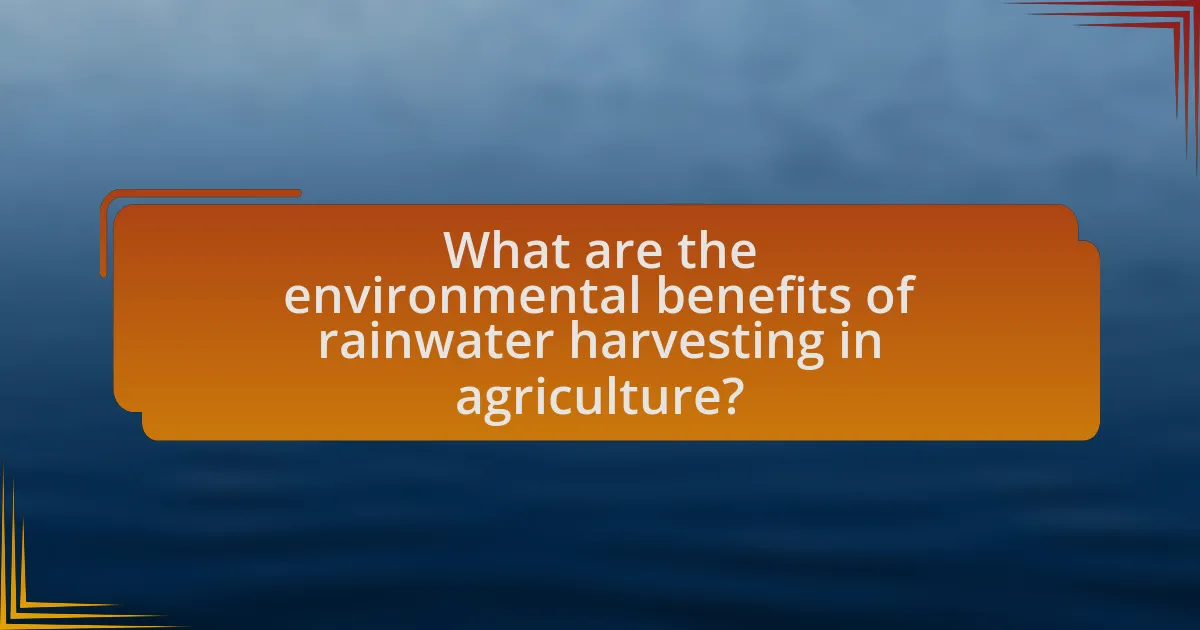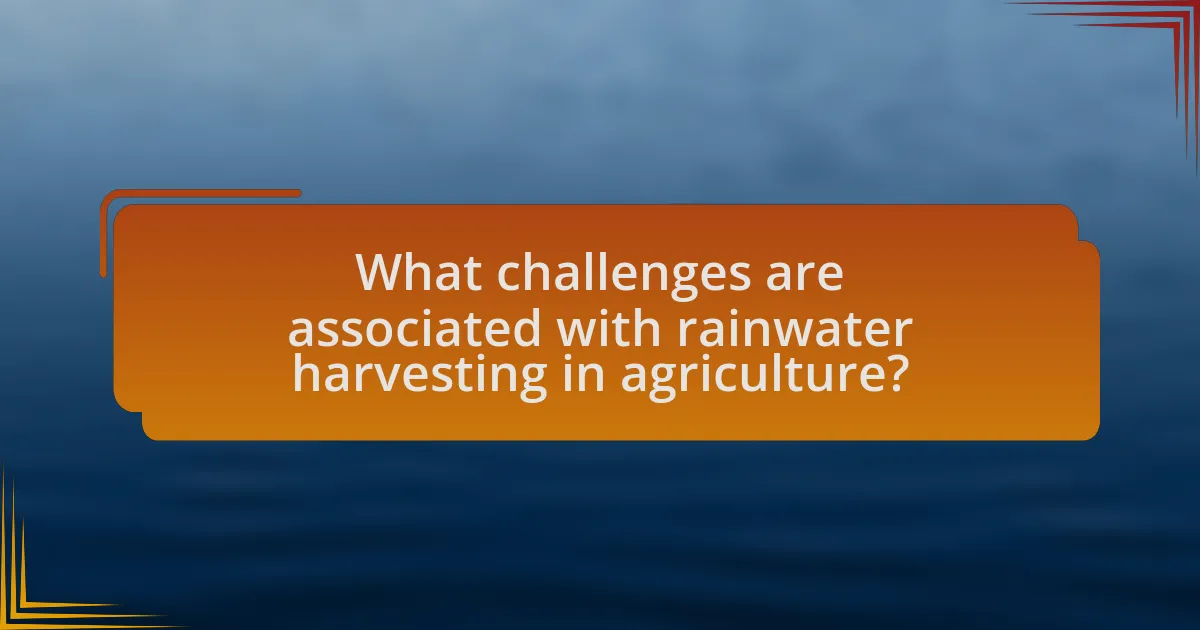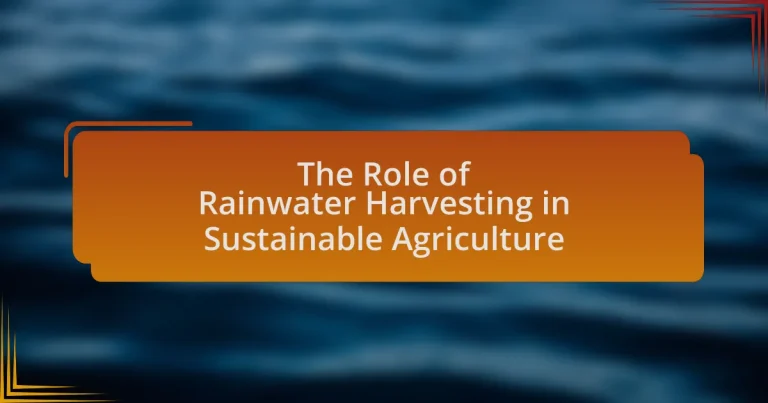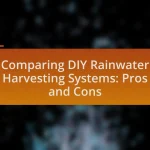Rainwater harvesting is a vital practice in sustainable agriculture, serving as an alternative water source that enhances crop production while conserving groundwater. This article explores the significance of rainwater harvesting in improving agricultural productivity, particularly in arid and semi-arid regions, where it can increase crop yields by up to 50%. Key techniques such as rooftop collection, surface runoff harvesting, and contour farming are discussed, along with the environmental benefits, including reduced soil erosion and improved biodiversity. Additionally, the article addresses the economic advantages, challenges, and best practices for implementing rainwater harvesting systems, emphasizing its role in promoting food security and sustainable farming practices.
What is the Role of Rainwater Harvesting in Sustainable Agriculture?

Rainwater harvesting plays a crucial role in sustainable agriculture by providing an alternative water source that enhances crop production while conserving groundwater. This practice captures and stores rainwater for agricultural use, reducing dependency on traditional irrigation methods and mitigating the effects of drought. Studies indicate that rainwater harvesting can increase agricultural productivity by up to 50% in arid regions, demonstrating its effectiveness in improving food security. Additionally, it helps in soil moisture retention, which is vital for crop growth, and reduces soil erosion, thereby promoting healthier ecosystems.
How does rainwater harvesting contribute to sustainable agricultural practices?
Rainwater harvesting significantly contributes to sustainable agricultural practices by providing a reliable source of water for irrigation, especially in arid and semi-arid regions. This method captures and stores rainwater, reducing dependency on groundwater and surface water sources, which are often overexploited. According to a study published in the journal “Water Resources Management,” implementing rainwater harvesting systems can increase crop yields by up to 50% in regions with limited water availability. Additionally, rainwater harvesting helps to mitigate soil erosion and improve soil moisture retention, further enhancing agricultural productivity and sustainability.
What are the key techniques used in rainwater harvesting for agriculture?
The key techniques used in rainwater harvesting for agriculture include rooftop rainwater harvesting, surface runoff harvesting, and contour farming. Rooftop rainwater harvesting involves collecting rainwater from building rooftops and directing it into storage tanks for agricultural use. Surface runoff harvesting captures rainwater from land surfaces, directing it into ponds or reservoirs for irrigation. Contour farming, which involves plowing along the contours of the land, helps to slow down water runoff and increases water infiltration, enhancing soil moisture retention. These techniques are essential for improving water availability in agricultural practices, especially in arid and semi-arid regions, where they can significantly increase crop yields and promote sustainable farming practices.
How does rainwater harvesting improve soil moisture levels?
Rainwater harvesting improves soil moisture levels by capturing and storing rainwater for agricultural use, which directly increases the availability of water in the soil. This practice allows for the replenishment of groundwater and enhances the moisture content in the topsoil, leading to better crop growth and resilience against drought conditions. Studies have shown that implementing rainwater harvesting systems can increase soil moisture retention by up to 30%, significantly benefiting agricultural productivity and sustainability.
Why is rainwater harvesting important for food security?
Rainwater harvesting is crucial for food security as it provides a reliable source of water for irrigation, especially in arid and semi-arid regions where water scarcity is prevalent. By capturing and storing rainwater, farmers can ensure a consistent water supply for crops, which enhances agricultural productivity and resilience against droughts. Studies indicate that implementing rainwater harvesting systems can increase crop yields by up to 50% in water-stressed areas, thereby directly contributing to food availability and security.
How does rainwater harvesting impact crop yields?
Rainwater harvesting significantly enhances crop yields by providing a reliable source of irrigation during dry periods. This method captures and stores rainwater, which can be utilized to irrigate crops, thereby reducing dependency on conventional water sources. Studies have shown that farms employing rainwater harvesting techniques can experience yield increases of up to 30% compared to those relying solely on traditional irrigation methods. For instance, research conducted by the International Water Management Institute demonstrated that rainwater harvesting improved crop productivity in arid regions, leading to better food security and sustainable agricultural practices.
What role does rainwater harvesting play in drought-prone areas?
Rainwater harvesting plays a crucial role in drought-prone areas by providing an alternative water source for agricultural and domestic use. This practice captures and stores rainwater, which can be utilized during dry periods, thereby reducing dependency on unreliable groundwater and surface water sources. Studies indicate that rainwater harvesting can increase water availability by up to 50% in regions with low rainfall, significantly enhancing crop yields and food security. For instance, research conducted in India demonstrated that implementing rainwater harvesting systems improved agricultural productivity by 30% in drought-affected areas, showcasing its effectiveness in mitigating the impacts of water scarcity.
What are the environmental benefits of rainwater harvesting in agriculture?

Rainwater harvesting in agriculture provides significant environmental benefits, including reduced soil erosion, improved water quality, and enhanced biodiversity. By capturing and utilizing rainwater, farmers can minimize surface runoff, which often leads to soil degradation and nutrient loss. Studies indicate that effective rainwater harvesting can decrease soil erosion rates by up to 50%, thereby preserving the topsoil essential for crop growth. Additionally, rainwater harvesting helps to filter pollutants, leading to improved water quality in nearby water bodies. This practice also supports biodiversity by creating habitats for various species, as stored rainwater can be used to maintain local ecosystems during dry periods.
How does rainwater harvesting reduce soil erosion?
Rainwater harvesting reduces soil erosion by capturing and storing rainwater, which decreases surface runoff and promotes groundwater recharge. When rainwater is harvested, it allows for gradual infiltration into the soil rather than rapid runoff that can wash away topsoil. Studies have shown that implementing rainwater harvesting systems can lead to a significant reduction in soil erosion rates, with some research indicating reductions of up to 50% in vulnerable areas. This practice not only conserves soil but also enhances soil moisture, supporting plant growth and further stabilizing the soil structure.
What practices can enhance the effectiveness of rainwater harvesting?
Implementing proper filtration systems enhances the effectiveness of rainwater harvesting by ensuring that collected water is free from contaminants. Effective filtration, such as using mesh screens or sediment filters, prevents debris and pollutants from entering storage tanks, thereby improving water quality. Additionally, regular maintenance of storage systems, including cleaning and inspection, ensures optimal performance and longevity. Research indicates that systems with well-maintained components can increase water collection efficiency by up to 30%. Furthermore, integrating rainwater harvesting with sustainable landscaping practices, such as planting native vegetation, can improve water absorption and reduce runoff, further enhancing the overall effectiveness of the system.
How does rainwater harvesting contribute to biodiversity?
Rainwater harvesting contributes to biodiversity by creating habitats that support various plant and animal species. This practice enhances soil moisture, which promotes the growth of diverse vegetation, thereby attracting a range of wildlife. Studies indicate that areas utilizing rainwater harvesting can experience increased species richness, as the availability of water encourages the establishment of native plants that provide food and shelter for local fauna. Additionally, rainwater harvesting reduces reliance on groundwater, helping to maintain the ecological balance of surrounding ecosystems.
What are the economic advantages of implementing rainwater harvesting?
Implementing rainwater harvesting provides significant economic advantages, including reduced water costs and increased agricultural productivity. By capturing and utilizing rainwater, farmers can decrease their reliance on expensive municipal water supplies or groundwater, leading to lower operational costs. For instance, a study by the International Water Management Institute found that rainwater harvesting can reduce water costs by up to 50% in some regions. Additionally, the availability of harvested rainwater can enhance crop yields, as it provides a reliable water source during dry periods, ultimately increasing farmers’ income. This dual benefit of cost savings and improved productivity underscores the economic viability of rainwater harvesting in sustainable agriculture.
How can rainwater harvesting reduce irrigation costs for farmers?
Rainwater harvesting can significantly reduce irrigation costs for farmers by providing a free and sustainable source of water for crop irrigation. By collecting and storing rainwater, farmers can decrease their reliance on expensive groundwater or municipal water supplies, which often incur high costs. For instance, a study by the Food and Agriculture Organization (FAO) indicates that implementing rainwater harvesting systems can lower irrigation costs by up to 50% in regions where water scarcity is prevalent. This reduction in costs is achieved through the efficient use of local rainfall, minimizing the need for energy-intensive pumping and treatment processes associated with conventional water sources.
What financial incentives exist for farmers adopting rainwater harvesting?
Farmers adopting rainwater harvesting can access various financial incentives, including government subsidies, tax breaks, and grants. These incentives are designed to encourage sustainable practices and improve water management. For instance, programs like the Environmental Quality Incentives Program (EQIP) in the United States provide financial assistance to farmers implementing conservation practices, including rainwater harvesting systems. Additionally, some regions offer tax credits for investments in water conservation technologies, which can significantly reduce the initial costs associated with installing rainwater harvesting systems.
What challenges are associated with rainwater harvesting in agriculture?

Rainwater harvesting in agriculture faces several challenges, including infrastructure costs, water quality issues, and seasonal variability. The initial investment for constructing storage systems and distribution networks can be significant, often deterring farmers from adopting these practices. Additionally, the quality of harvested rainwater can be compromised by contaminants, which may affect crop health and yield. Seasonal variability in rainfall patterns can lead to inconsistent water supply, making it difficult for farmers to rely solely on harvested rainwater for irrigation. These challenges highlight the need for effective planning and management strategies to optimize rainwater harvesting in agricultural settings.
What are the common barriers to implementing rainwater harvesting systems?
Common barriers to implementing rainwater harvesting systems include high initial costs, lack of awareness, regulatory challenges, and technical limitations. High initial costs can deter individuals and organizations from investing in the necessary infrastructure, as systems can require significant financial outlay for materials and installation. Lack of awareness about the benefits and feasibility of rainwater harvesting can lead to underutilization, as potential users may not understand how to effectively implement such systems. Regulatory challenges often arise from unclear or restrictive local laws that govern water collection, which can complicate the installation process. Additionally, technical limitations, such as inadequate design or maintenance knowledge, can hinder effective system operation and reduce user confidence in rainwater harvesting.
How can farmers overcome technical challenges in rainwater harvesting?
Farmers can overcome technical challenges in rainwater harvesting by implementing advanced technologies such as rainwater harvesting systems that utilize efficient storage and filtration methods. These systems can include the use of cisterns, permeable surfaces, and rain gardens, which enhance water collection and reduce evaporation losses. Research indicates that integrating these technologies can increase water availability by up to 50% in arid regions, thereby improving agricultural productivity. Additionally, training programs focused on best practices for system maintenance and optimization can further empower farmers to effectively manage their rainwater harvesting systems, ensuring sustainability and resilience in their agricultural practices.
What are the regulatory hurdles related to rainwater harvesting?
Regulatory hurdles related to rainwater harvesting include legal restrictions, permitting processes, and compliance with health and safety standards. Many jurisdictions have specific laws that govern the collection and use of rainwater, which can vary significantly, leading to confusion and potential non-compliance. For instance, some regions require permits for installation, while others may restrict the use of harvested rainwater for potable purposes due to health concerns. Additionally, regulations may mandate specific design standards for storage systems to prevent contamination. These complexities can hinder the adoption of rainwater harvesting practices, as stakeholders must navigate a patchwork of regulations that can be time-consuming and costly to comply with.
How can farmers effectively integrate rainwater harvesting into their practices?
Farmers can effectively integrate rainwater harvesting into their practices by implementing systems such as rooftop catchment, surface runoff collection, and storage tanks. These systems allow farmers to capture and store rainwater for irrigation, reducing dependency on groundwater and improving water availability during dry periods. Research indicates that rainwater harvesting can increase crop yields by up to 50% in arid regions, demonstrating its effectiveness in enhancing agricultural productivity while promoting sustainable water management.
What best practices should be followed for successful rainwater harvesting?
Successful rainwater harvesting requires careful planning and implementation of best practices. First, selecting an appropriate catchment area, such as rooftops, ensures maximum water collection efficiency. Additionally, using clean and non-toxic materials for gutters and storage tanks prevents contamination of harvested water. Regular maintenance of the system, including cleaning gutters and inspecting tanks, is crucial to ensure optimal performance and water quality. Implementing filtration systems can further enhance water purity, making it suitable for various agricultural uses. According to the Food and Agriculture Organization, effective rainwater harvesting can increase water availability for irrigation, thereby supporting sustainable agricultural practices.
How can farmers monitor and evaluate the effectiveness of their rainwater harvesting systems?
Farmers can monitor and evaluate the effectiveness of their rainwater harvesting systems by implementing regular data collection and analysis methods. This includes measuring the volume of water collected, assessing the quality of the harvested water, and tracking the impact on crop yield and soil moisture levels. For instance, using flow meters can provide precise measurements of water volume, while soil moisture sensors can help determine how effectively the harvested water is utilized by crops. Additionally, farmers can conduct periodic assessments of crop health and productivity to correlate these metrics with the performance of their rainwater harvesting systems, thereby establishing a clear link between water management practices and agricultural outcomes.


